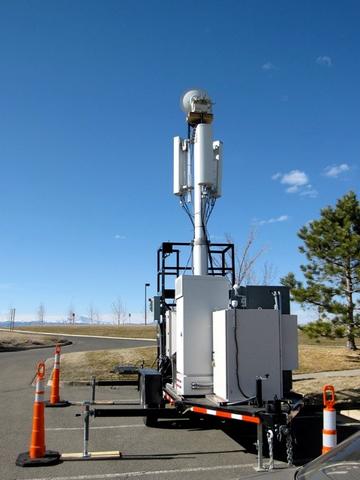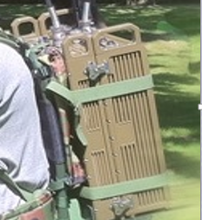Summary
The use of deployable systems in public safety operations can help provide first responders with critical communications in areas that do not have sufficient coverage. The Public Safety Communications Research (PSCR) program is examining different types of deployable systems across the industry with respect to key features of the public safety network. The results of these efforts will support public safety stakeholders in planning and setting requirements.
Description

Sample of a Cell-On-Wheel (COW) Deployable System
The Middle Class Tax Relief and Job Creation Act of 2012 (H.R. 3630) appropriated $7 billion for the establishment of a nationwide interoperable public safety broadband network (PSBN) under FirstNet, an independent authority in the National Telecommunications and Information Administration (NTIA). FirstNet will provide first responders with dedicated and prioritized access to high-speed data, voice, and other mission critical applications. Deployable systems are considered essential to fill the gaps not being covered by the fixed network. PSCR and the Communication Technology Laboratory (CTL) at NIST, in collaboration with the Department of Homeland Security (DHS) Office for Interoperability and Compatibility (OIC), are evaluating different land-based and airborne deployables systems in laboratory and in-field environments.
AN INNOVATIVE APPROACH
PSCR is testing and evaluating the following representative deployable systems: macro systems that provide broad coverage and accommodate many active users per cell; man-pack portable systems with rapid deployment time that are capable of handling a small team of active users; and vehicular systems with an intermediate range of coverage.
For each system, PSCR uses the following approach:
• Examine key aspects of the deployable system, including: coverage, mission critical voice communications, group communications, resiliency, ease of use, power source, back haul options, and RF radiation safety
• Assess how the system operates in isolation (standalone)
• Evaluate how the deployable system can interoperate with the nationwide fixed PSBN and with other deployable systems, including deployable systems from federal/state/provincial agencies in support of disaster response
• Examine ways in which the deployment time (power-on to fully operational) of these systems can be minimized
Airborne deployable systems could bring unique aspects to the deployables arena and will be considered as another option differentiating from land-based systems.
VALUE TO PUBLIC SAFETY
PSCR is assessing the state of industry for current technologies of deployable systems with respect to public safety requirements. PSCR will provide insight to guide standards development efforts, planning, and setting systems requirements.


